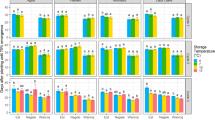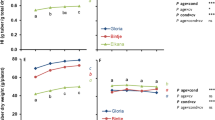Summary
The effect of two planting dates upon the physiological age of seed tubers, measured by their incubation period, and their yielding potential was studied during a three-year period with two medium-early and one medium-late cultivar. Although seed tubers of the December planting were physiologically significantly younger than those obtained from the November planting in two of the three seasons studied, no reliable effect upon tuber yield was found. Reasons for this lack of relation are discussed. The accumulated day-degrees above 17°C (daily mean temperature) during the bulking period of the seed crop modified the incubation period of the tubers clearly.
Zusammenfassung
Der Einfluss zweier Pflanztermine auf das physiologische Alter von Pflanzkartoffeln und ihr Ertragspotential wurde während einer Dreijahresperiode an zwei mittelfrühen Sorten, Spunta und Kennebec, und einer mittelspäten Sorte, Bonaerense la Ballenera MAA, in warmer gemässigter Klimazone in Argentinien geprüft. Saatbestände aus November- und Dezemberpflanzungen von 1979, 1980 und 1981 wurden im November 1980, 1981 und 1982 in vergleichenden Ertragsversuchen gepflanzt. Das physiologische Alter der Knollen wurde bei der Pflanzung durch die Inkubationsperiode (Claver, 1973, 1975) gemessen. Abb. 1 zeigt die meteorologischen Daten der vier Vegetationsperioden. Es ergaben sich signifikante Unterschiede im physiologischen Alter zwischen den Sorten und den Pflanzterminen (Tab. 1). Bei Lagerung der Saatkartoffeln in Mieten im Feld beschleunigte sich das physiologische Alter (Tab. lc).
Die Gesamtknollenerträge schwankten zwischen den Sorten in 1980/81 und 1982/83 (Tab. 2a und 2c), es ergaben sich jedoch keine signifikanten Unterschiede zwischen Pflanzgut der beiden Pflanztermine, obwohl sich zwischen beiden Pflanzterminen Unterschiede im physiologischen Alter ergaben. Der Gesamtknollenertrag war 1982/83 am höchsten (Tab. 2c), obwohl die Pflanzknollen physiologisch die Ältesten waren.
Es ist unwahrscheinlich, dass eine hohe prozentuale Infektionsrate mit PLRV und PVY der Pflanzknollen von Spunta und Kennebec aus der Dezemberflanzung den Einfluss des physiologischen Alters auf den Ertrag derart überdeckte, dass keine signifikanten Unterschiede mehr gefunden werden konnten (Abb. 2). Weil die Unterschiede im physiologischen Alter innerhalb einer Sorte jedoch klein waren, waren andere ertragsbestimmende Faktoren offensichtlich wichtiger als die Unterschiede im Alter.
Die akkumulierten Tagesgrade über einer täglichen Temperatur von 17°C während der Periode des Knollenansatzes hatten eine klare Änderung der Inkubationsperiode zur Folge.
Résumé
L'effet de deux dates de plantation sur l'âge physiologique de tubercules de semence et sur leur rendement potentiel a été étudié durant une période de trois années avec deux variétés demi-hâtives, Spunta et Kennebec, et une demi-tardive, Bonaerense la Ballenera MAA, cultivées dans un climat chaud d'Argentine. Les plants récoltés en novembre et décembre des années 1979, 1980 et 1981 ont été plantés en novembre 1980, 1981 et 1982 selon des essais comparables de rendement. L'âge physiologique des tubercules était évalué à la plantation par la période d'incubation (Claver, 1973, 1975). Les relevés météorologiques pour les quatres saisons sont donnés dans la fig. 1. On observait des différences significatives dans l'âge physiologique entre les variétés et les dates de plantation (tabl. 1). Quand les tubercules de semence étaient conservés en silo au champ, l'âge physiologique était avancé (tabl. lc).
Le rendement total en tubercules était différent entre variétés pour 1980/81 et 1982/83 (tabl. 2a et 2c) mais il n'y avait pas de différences significatives entre les plants des deux dates de plantation bien qu'il y ait des différences significatives dans leur âge physiologique. Le rendement total en tubercules était plus élevé en 1982/83 (tabl. 2c) malgré des tubercules de semence physiologiquement plus vieux.
Il est peu probable que le taux important d'infection par les virus de l'enroulement et Y des semences de Spunta et Kennebec observé de l'âge physiologique des plants sur les rendements, ceux-ci ne présentant aucune différence significative (fig. 2). De plus, parce que les différences d'âge physiologique des semences au sein d'une variété sont-faibles, d'autres facteurs déterminants que le rendement doivent avoir été plus importants que la différence d'âge.
Le cumul jour-degrés au-dessus de la température journalière de 17°C durant la période de tubérisation des tubercules de semence modifie sensiblement la durée d'incubation des plants (fig. 3).
Similar content being viewed by others
References
Caldiz, D. O., F. K. Claver & A. R. Escande, 1984. Effect of harvesting time and storage system on the quality of seed potato tubers (Solanum tuberosum L.)Turrialba 34: 287–290.
Caldiz, D. O., J. R. Alaniz & F. K. Claver, 1985. Relaciones entre el contenido de azúcares totales y reductores y la edad fisiológica de tubérculos de papa (Solanum tuberosum L.) destinados a nueva plantación.Turrialba 35 (in press).
Carls, J. & K. Caesar, 1979. Zum Einfluss der Lagerungs-und Aufwuchstemperatur auf das physiologische und den Nachbauwert von Pflanzkartoffeln unter tropischen Bedingungen.Potato Research 22: 87–97.
Claver, F. K., 1951. Influencia de luz, oscuridad y temperatura sobre la incubación de la papa.Phyton 1: 3–12.
Claver, F. K., 1953. Factores que influyen en la incubación de la papa.Turrialba 3: 32–34.
Claver, F. K., 1973. Influence of temperature during the formation of tubers in relation with their incubation state (physiological age) and seed value.Experientia 30: 97–98.
Claver, F. K., 1975. Influence of temperature during the formation of potato tubers and its effects on the first progeny.Phyton 33: 1–5.
Claver, F. K., R. M. Tizio & E. R. Montaldi, 1957. Efecto degenerativo de altas temperaturas durante la formación de los tubérculos de papa.Revista de Investigaciones Agrícolas, Argentina 11: 209–214.
Es, A. van & K. J. Hartmans, 1984. Some aspects of changes in chemical composition of tubers and sprouts during physiological ageing. Abstracts of Conference Papers, 9th Triennial Conference of the EAPR (Interlaken), p. 231–232.
Ewing, E. E., 1981. Heat stress and the tuberization stimulus.American Potato Journal 58: 31–49.
Gregory, L. E., 1965. Physiology of tuberization in plants (Tubers and tuberous roots).Encyclopedia Plant Physiology 15: 1328–1354.
Hartmans, K. J. & A. van Es, 1981. Aspects and preliminary results of research on physiological ageing and sprouting capacity. Abstracts of Conference Papers, 8th Triennial Conference of the EAPR (München), p. 68–69.
Hay, R. K. M. & E. J. Allen, 1978. Tuber initiation and bulking in the potato (Solanum tuberosum L.) under tropical conditions: the importance of soil and air temperature.Tropical Agriculture, Trinidad 55: 289–295.
Iritani, W. M., 1968. Factors affecting physiological ageing (degeneration) of potato tubers used as seed.American Potato Journal 45: 111–116.
Iritani, W. M., 1981. Relationships of stem number, tuber set and yield of Russet Burbank potatoes. Abstracts of Conference Papers, 8th Triennial Conference of the EAPR (München), p. 145–146.
Loon, C. D. van & J. F. Houwing, 1981. Aspects and preliminary results of physiological age. 3. Incubation period and plant growth under field conditions. Abstracts of Conference Papers, 8th Triennial Conference of the EAPR (München), p. 72–73.
McCown, B. H. & I. Kass, 1977. Effect of production temperature of seed potatoes on subsequent yielding potential.American Potato Journal 54: 277–287.
O'Brien, P. J. & E. J. Allen, 1981. The concept and measurement of physiological age. Abstracts of Conference Papers, 8th Triennial Conference of the EAPR (München), p. 64–66.
O'Brien, P. J., E. J. Allen, J. N. Bean, R. J. Griffith, S. A. Jones & J. L. Jones, 1983. Accumulated day-degrees as a measure of physiological age and the relationships with growth and yield in early potato varieties.Journal of Agricultural Sciences, Cambridge 101: 613–631.
Panelo, D. M., D. O. Caldíz & F. K. Claver, 1982. La tuberización y el rendimiento de tres variedades de papa cultivades en Miramar, Argentina.Revista Facultad de Agronomía, La Plata 58: 99–120.
Pérennec, P. & P. Madec, 1980. Age physiologique du plant de pomme de terre. Incidence sur la germination et repercusions sur le comportement des plantes.Potato Research 23: 183–199.
Reestman, A. J., 1970. Importance of the degree of virus infection for the production of ware potatoes.Potato Research 13: 248–268.
Reust, W., 1981. Relation entre la durée d'incubation, l'age physiologique et le rendement des pommes de terre. Abstracts of Conference Papers, 8th Triennial Conference of the EAPR (München), p. 76–77.
Reust, W., 1982. Contribution à l'appréciation de l'age physiologique des tubercules de pomme de terre (Solanum tuberosum L.) et étude de son importance sur le rendement. These, Dr. Sc. Tech. Ecole Polytechnique Fédérale, Zürich, 113 pp.
Reust, W. & J. Münster, 1975. La période d'incubation des variétés de pommes de terre de l'assortiment suisse et son importance.Revue Suisse Agriculture 7: 185–187.
Sacher, R. F. & W. M. Iritani, 1982. Tetrazolium test as indicators of tuber physiological age and yield potential.American Potato Journal 59: 613–625.
Slater, J. W., 1968. The effect of night temperatures on tuber initiation of the potato.European Potato Journal 11: 14–22.
Went, F. W., 1959. Effects of environment of parent and grandparent generations on tuber productivity by potatoes.American Journal of Botany 46: 277–282.
Author information
Authors and Affiliations
Rights and permissions
About this article
Cite this article
Caldiz, D.O., Panelo, D.M., Claver, F.K. et al. The effect of two planting dates on the physiological age and yielding potential of seed potatoes grown in a warm temperate climate in Argentina. Potato Res 28, 425–434 (1985). https://doi.org/10.1007/BF02357517
Accepted:
Issue Date:
DOI: https://doi.org/10.1007/BF02357517




